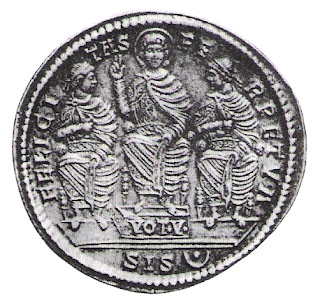Byzantine civilization is not only composed of Roman roots. It also merges the ancient Greek past and Orthodox Christianity together with Roman legacy.
THE CRISIS OF THE THIRD CENTURY, SURVIVAL OF THE EAST AND COLLAPSE OF THE WEST, THE CHRISTIAN CHURCH
The third century reforms could not ease the situation in the West, nevertheless the East survived because it was more urbanized and cultured, it had a healthier economy, thanks to Eastern diplomacy, thanks to Constantinople, and also there were more Christians in the East.
Religious Conflicts
These are the heresies which attempted to define the exact nature of Christ and the relationship among the members of the Holy Trinity:
1.Donatism,
2.Arianism,
3.Nestorianism,
4.Monophysitism.
External Threats
Germanic invasions in the third, fourth and fifth centuries were the most serious external threat for both the eastern and the western halves of the empire. While the Byzantine state was able to expel these peoples, the Western half was not able to do so, and collapsed in the end in 476.
JUSTINIANIC AGE, NEW ENEMIES, AND“THE DARK AGE”
Justinian I (527-565) wanted to create a strong empire covering the Mediterranean with a single religion and with a proper legal system. To attain his goal, he attempted a number of recuperative efforts:
1.Legal reform,
2.Religious unity,
3.Administrative efficiency,
4.Reconquest of the Western provinces,
5.Building program,
6. lasting peace with the Persians
New Enemies and the “Dark Age”
The seventh century is actually a period of crisis. After Justinian, Byzantine Empire had to endure new problems such as the plague and external enemies who were the Slavs, Avars, Bulgars, Sassanids, and Arabs.
FROM THE ICONOCLASTIC CONTROVERSY TO THE GREAT SCHISM
Byzantium overcame the “dark age” thanks to its new military structure, survival of taxation and maybe iconoclasm.
Iconoclasm
Iconoclasm means image-smashing. A number of reasons are attested for this movement:
Losses of battles against Arabs, (This approach does not stand firm, though.) and the rise of monasteries.
Macedonian Dynasty
With the recovery of economy, Byzantine state changed its defensive strategy to offensive and reconquered much territory that it lost. However, the empire again had new enemies: Seljuk Turks, Normans and Pechenegs.
FROM THE AGE OF CRUSADES TO THE OTTOMAN CONQUEST
In the early eleventh century the empire was large, rich and cultured, but it had some issues with the westerners concerning religion. The issue was called Great Schism. The primary causes of the Schism were disputes over papal authority.
SAVING THE STATE
In battlefield
Alexios, his son and his grandson fought against these three enemies as well as Crusaders.
In fiscal issues
He completely reformed the coinage.
In 1204, Crusaders seized Constantinople and cruelly sacked it. They established the Latin Empire (1204–61). There were the Byzantine successor states: Epirus, Nicaea and Trebizond.
RECONQUEST OF CONSTANTINOPLE, THE FALL OF THE BYZANTINE EMPIRE
With the reconquest of Constantinople, new challenges and problems awaited Michael Palaiologos, and his successors like the reconquest of the lost territories. By 1350s, this entire edifice had crumbled as a result of a civil war in (1342–54). The Byzantine Empire became tributary to the Ottomans.
Byzantium as an Ottoman vassal and its end
Byzantines asked for Western help to get rid of the Ottoman yoke. Thus they accepted the church union, by which they got under the papal suzerainty. However, after a siege by land and by sea, the city of Constantine was conquered by Mehmed II in 1453.
Mehmed II and Gennadios Scholarios (First Patriarch after the Conquest)


